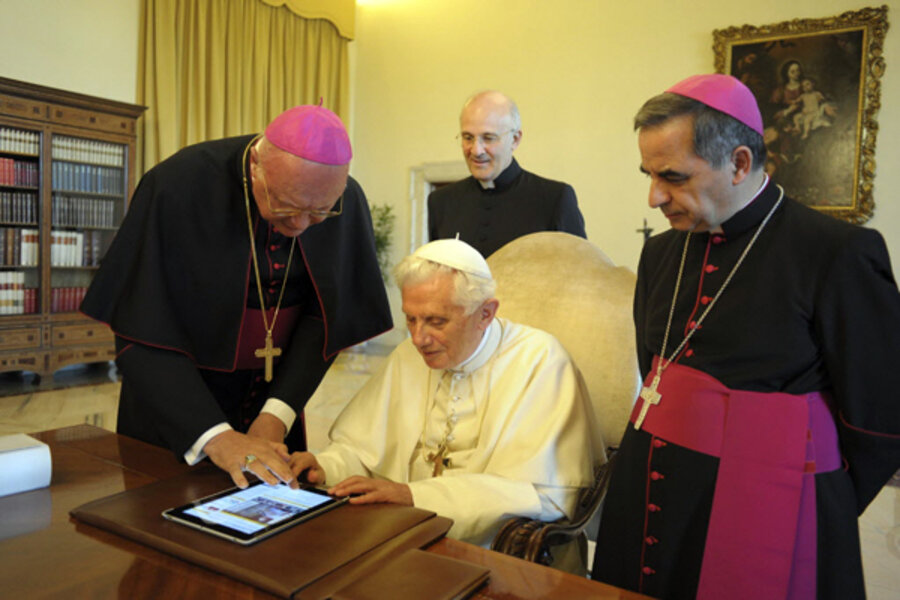The pope joins the twitterverse as @pontifex
Loading...
| Vatican City
After centuries of issuing theology-heavy treatises and ponderous papal bulls, the Vatican on Monday announced that the pope was embracing the most succinct of communications – Twitter.
Pope Benedict XVI is famously technology-averse – not surprising, perhaps, given that he is 85 years old and a theologian by training – but the Vatican insisted that he would start tweeting regularly in English and six other languages Dec 12.
The initiative is an attempt to take the fullest advantage of new media to spread the teachings of the Gospels, amid intense efforts by the Vatican to make its message more accessible, especially to the young.
It will be a radical departure for the German-born pontiff, who last month published the third and final volume of a weighty study on the life of Jesus Christ.
The Vatican, steeped in a tradition in which quickness and conciseness were often markedly absent, insisted that the Gospels were ideally suited to being reduced to pithy, 140-character tweets, but acknowledged there would be a steep learning curve ahead.
“It’s going to be a challenge to find the appropriate language to produce a sweet, short message and to learn the fluency of the language,” said Monsignor Paul Tighe, an Irish priest who is the secretary of the Pontifical Council for Social Communications.
Communication problems
Pope Benedict’s seven-year papacy has been marred by communications mishaps and misunderstandings on subjects ranging from his attitude toward Islam, his position on condoms and the prevention of AIDs, and the worldwide pedophile-priest sex-abuse scandals.
The Vatican is trying to reach out to an increasingly Internet-savvy audience and has already established a presence on YouTube and Facebook.
Twitter will help disseminate a clearer, more easily understandable message to Twitter’s 140 million regular users, 40 percent of whom are between the ages of 18 and 34.
“There is a strong desire by the pope to enter into a dialogue with the men and women of today,” said Archbishop Claudio Maria Celli, the president of the Pontifical Council for Social Communications.
The initiative proved spectacularly successful on its first day, before the pope had even sent his first tweet – within hours he had more than 130,000 followers, with bookmakers like Ladbrokes predicting that he would reach the 1 million mark by Christmas.
Despite his newfound enthusiasm for new media, the pope will not succumb to the sort of obsession that strains relationships and workplaces around the world, officials said.
“The pope is not the kind of person who, when they are in a meeting or at lunch, looks at his BlackBerry to see if there are new messages. He’s not walking around with an iPad,” said Greg Burke, the Vatican’s media consultant.
The pope is unlikely to follow other Twitter users and will not be engaging in debate with people who send him messages.
His tweets will be confined to matters of faith and Christian theology.
“Twitter is a new market of ideas and the church needs to be there. It’s cost-effective, it’s not very labor intensive, and it connects with young people,” said Mr. Burke, a former Fox News correspondent in Rome who was hired to improve the Vatican’s media strategy earlier this year.
New handle: @pontifex
The "handle" apparently chosen by Pope Benedict XVI, @pontifex, evokes his role as a bridge between the church and more than 1 billion Roman Catholics around the world.
Like any Twitter user, the pope will be exposed to potential insults and abuse. “It’s a platform built on open information. I think the truth, the positivity will rise to the top, but there are risks when you come on board,” said Claire Diaz-Ortiz, a representative from Twitter.
Pope Benedict will not type his tweets himself – that will be done by a communications team – but he will approve every message.
“Every tweet will have been personally seen and approved by the pope. They will be pearls of wisdom coming from the heart of his teaching,” said Monsignor Tighe.
Archbishop Celli said the pope's tweets were not infallible. "It is not dogma – it is more like the pope having a conversation," he told a packed press conference in the Vatican.







